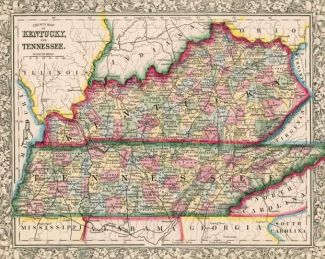 The Stamping Ground Baptist Church in Scott County, Kentucky represents a common historical trajectory of many Baptist congregations formed in the South at the turn of the 19th century.
The Stamping Ground Baptist Church in Scott County, Kentucky represents a common historical trajectory of many Baptist congregations formed in the South at the turn of the 19th century.
Founded by Baptist pioneers relocating to the Southern frontier, the Stamping Ground church from its inception is comprised of both white and black members, the latter being slaves. As is the case with many contemporary Baptist congregations of the South that experience growth, the ratio of black members (nearly always slaves, with few exceptions) to whites increases with time, to the point that in the 1840s black members are allowed to hold their own services, under the supervision of white church leaders. This arrangement allows slave members limited control over their corporate spiritual life and expression, the one sphere in a slave’s life where some freedom can be exercised.
While separate services for black members are common in many Baptist churches of the South by the 1850s, the Stamping Ground Baptist Church in 1855 takes a step that relatively few sister churches dare: the congregation votes to allow black members to form a separate congregation that, nonetheless, remains under the supervision of the mother white church. This model expands slaves’ spiritual freedom a bit more, although the threat of discipline, should black members become too uppity, is always present.
In July 1855, the church notifies the Elkhorn Association that “Our colored brethren having been organized into a separate church will hereafter be known as the African Baptist Church at Stamping Ground, under the care of the Stamping Ground Church.” Four years later, “The African church under our watch care is in a flourishing condition.” In July 1860, the membership of the white congregation numbers 333, while the black congregation numbers 334. Three months later, the “African congregation” outgrows their facilities, and the Stamping Ground Baptist Church appoints a committee to “consult about rebuilding or enlarging African meeting house.”
Then comes the war over African slavery, bringing to the forefront latent distrust and tensions that had always characterized relationships between free white and enslaved black members of Baptist congregations of the South.
This month, white members of the Stamping Ground congregation appoint three church leaders to “be a committee to visit the African church and settle any difficulties in the same and to have unlimited control over the proceedings of the church until further instructed by the church.” For the remainder of the war, the white congregation maintains a close watch over their black members as the master-slave relationship in the South gradually crumbles. Finally, less than a year after the war ends and slavery is abolished, in January 1866 the white Stamping Ground Baptist Church severs ties with the African Baptist Church at Stamping Ground. Now autonomous, the former slaves are finally able to worship God unhindered.
In the broader picture, white Baptists in the immediate post-war years are typically reluctant yet resigned to detaching themselves from their former slaves, while freedmen joyously embrace spiritual autonomy. Never again, to the present, will Baptist congregations of the South be as integrated as they were during the days of African slavery.
Source: J. W. Singer, “Stamping Ground Baptist Church, Scott County, Kentucky: The Negro Members,” in A History of the Baptist Church at Stamping Ground, Kentucky, 1795-, pp. 41-48, 1970 (link)
Note: Special thanks to Jim Duvall, creator of the BaptistHistoryHomepage.


